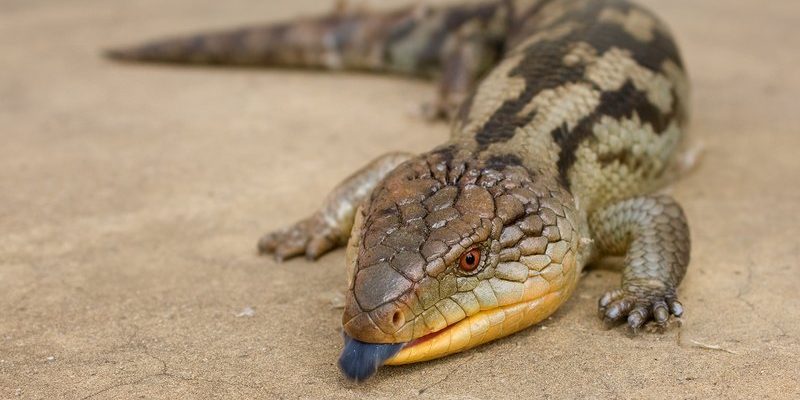![Blue-Tongue Skink Vs. [Similar Species] - How They Compare](https://gudri.com/wp-content/uploads/2025/06/Blue_Tongue_Skink_Vs___Similar_Species____How_They_Compare_image_0.jpg)
But here’s the thing: blue-tongue skinks aren’t alone in the reptile kingdom. There are several other species that share similar traits. Sharing the same habitat can lead to a lot of interesting comparisons. So, let’s dive into the differences and similarities between blue-tongue skinks and some of their close relatives, like the eastern skink or the common skink. Grab a cup of coffee, and let’s get into it!
What Are Blue-Tongue Skinks?
Blue-tongue skinks belong to the family Scincidae and are primarily found in Australia and New Guinea. They get their name from the striking blue color of their tongues, which they display as a defense mechanism. When threatened, a blue-tongue skink will open its mouth wide to flash its vibrant blue tongue, often startling potential predators. It’s a clever way to say, “Hey, back off!”
These lizards are generally known for their docile nature. Unlike some of their more skittish cousins, they can often be handled without creating much fuss. With a robust body and short legs, they often look a bit like a small, slow-moving sausage! Blue-tongue skinks are primarily herbivorous, enjoying a diet of leafy greens, fruits, and vegetables, although they may also eat insects on occasion.
What makes them especially appealing to reptile enthusiasts is their friendly disposition. They have a unique way of exploring the world around them—often slowly wandering rather than darting off. They also possess facial features that make them appear almost like they are smiling, adding to their allure.
Comparing Blue-Tongue Skinks to Eastern Skinks
Now let’s turn our attention to the eastern skink, another member of the skink family. While both species belong to the same broader family, they exhibit distinct differences in behavior, habitat, and appearance.
The eastern skink, specifically the Eastern Blue-Tongue Skink, can be found mostly along the Eastern coast of Australia and is slightly smaller than its blue-tongue cousin. Unlike the blue-tongue skink, the eastern skink tends to have a more streamlined body and is quicker on its feet. It also displays more variety in coloring—from browns to greens—which helps it camouflage within its environment.
While both species enjoy similar habitats, the eastern skink is often found in more wooded areas, preferring to hide among leaves and branches. They tend to be a bit more solitary, while blue-tongue skinks can sometimes be seen basking together in the sun.
Behavior and Temperament: Blue-Tongue vs. Other Skinks
Behaviorally, there’s a world of difference between blue-tongue skinks and their relatives. Blue-tongue skinks are quite approachable and often exhibit friendly behavior. They have a natural curiosity, allowing them to adapt well to being handled, which makes them popular pets.
On the other hand, skinks like the common skink may be more evasive. They tend to dash away when approached, showing a more anxious temperament. Common skinks are often active foragers, darting between grass and rocks in search of food. While they can be fascinating to observe, their skittish nature makes them less suited to become pets.
If you’re considering adopting a skink, think about how much interaction and handling you want. Blue-tongue skinks are great for beginners who want a lively reptile companion, while more timid species like the common skink might not enjoy being handled as much.
Dietary Differences: What Blue-Tongue Skinks Eat
When it comes to food, blue-tongue skinks have a diverse diet that includes a mixture of vegetables, fruits, and proteins. Some common staples include:
- Leafy greens (like collard greens and dandelion leaves)
- Fruits (berries, melons, and apples)
- Insects (mealworms or crickets, occasionally)
This balanced diet is important for their health, helping them maintain a healthy weight and vibrant skin.
In contrast, other skinks, such as the common skink, tend to be insectivorous, focusing mainly on a diet of insects and worms. They require a higher protein intake compared to blue-tongue skinks, which may limit their diet options in captivity. It’s worth noting that this difference can affect how you set up their habitats and care for them.
If you’re looking at adopting one of these lizards, be sure to research their dietary needs carefully. It’s crucial to give them the right kind of food to keep them happy and healthy!
Habitat Preferences: Where Do They Live?
Blue-tongue skinks thrive in a variety of habitats, from open forests and woodlands to grasslands and scrubland. They’re adaptable creatures that can often be seen basking on rocks or logs, soaking up the sun during the day. Since they’re relatively slow movers, their habitat needs are less focused on speed and more on comfort and food availability.
In contrast, other skinks, like the eastern skink, tend to prefer more specific habitats. They often favor forest environments with abundant cover, as it provides protection from predators. Their choice of habitat can influence their behavior as well, making them more reclusive than the sociable blue-tongue.
Understanding the habitat preferences of these lizards is essential if you’re planning to keep one as a pet. Making sure to replicate their natural environment can help promote healthy behaviors and reduce stress.
So, whether you’re drawn to the friendly nature of the blue-tongue skink or curious about the more elusive eastern skink, understanding the differences between these species can help you make an informed choice. Blue-tongue skinks are ideal for those looking for an engaging pet that enjoys human interaction. They’re like the welcoming party hosts of the skink universe—ready to meet you with their blue tongues and friendly personalities.
On the other hand, species like the common skink may be better suited for more experienced reptile keepers who appreciate their unique beauty but understand their need for a quieter lifestyle.
In the end, both types of skinks offer their own special charms—just make sure to match their needs with your lifestyle! Remember, taking the time to learn about these reptiles helps ensure a happy life for both you and your future scaly friend.

